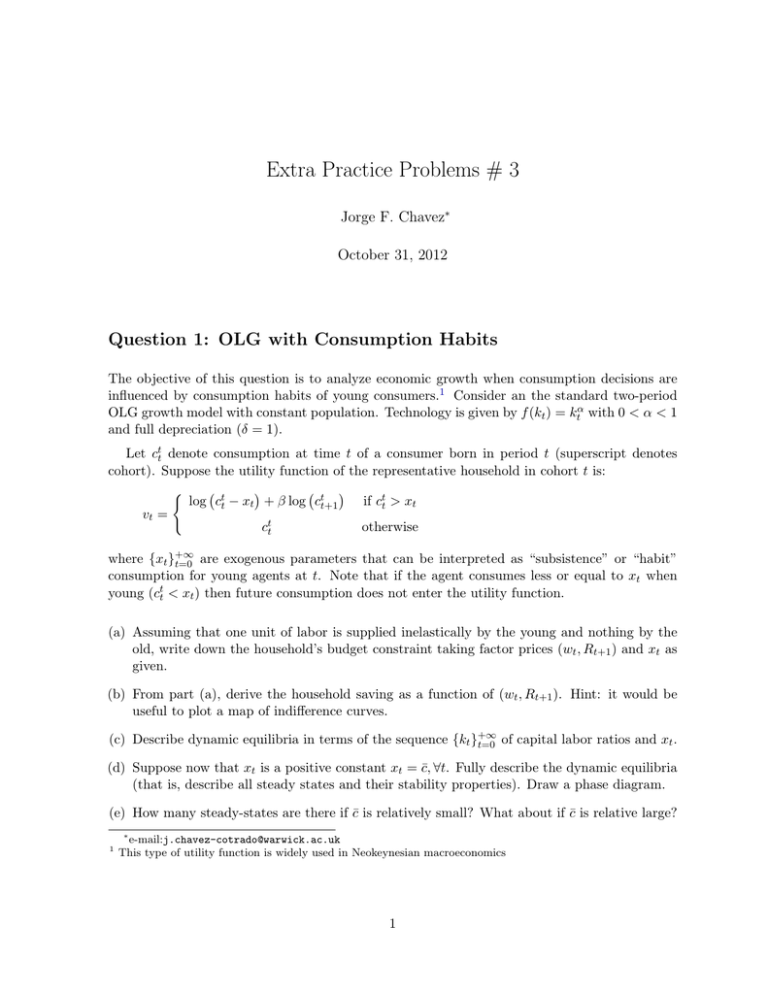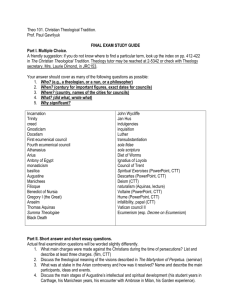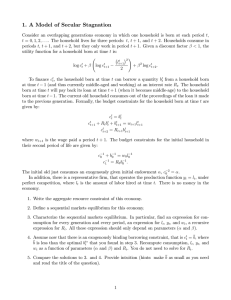Extra Practice Problems # 3 Question 1: OLG with Consumption Habits
advertisement

Extra Practice Problems # 3
Jorge F. Chavez∗
October 31, 2012
Question 1: OLG with Consumption Habits
The objective of this question is to analyze economic growth when consumption decisions are
influenced by consumption habits of young consumers.1 Consider an the standard two-period
OLG growth model with constant population. Technology is given by f (kt ) = ktα with 0 < α < 1
and full depreciation (δ = 1).
Let ctt denote consumption at time t of a consumer born in period t (superscript denotes
cohort). Suppose the utility function of the representative household in cohort t is:
(
)
(
)
{
log ctt − xt + β log ctt+1
if ctt > xt
vt =
ctt
otherwise
where {xt }+∞
t=0 are exogenous parameters that can be interpreted as “subsistence” or “habit”
consumption for young agents at t. Note that if the agent consumes less or equal to xt when
young (ctt < xt ) then future consumption does not enter the utility function.
(a) Assuming that one unit of labor is supplied inelastically by the young and nothing by the
old, write down the household’s budget constraint taking factor prices (wt , Rt+1 ) and xt as
given.
(b) From part (a), derive the household saving as a function of (wt , Rt+1 ). Hint: it would be
useful to plot a map of indifference curves.
(c) Describe dynamic equilibria in terms of the sequence {kt }+∞
t=0 of capital labor ratios and xt .
(d) Suppose now that xt is a positive constant xt = c̄, ∀t. Fully describe the dynamic equilibria
(that is, describe all steady states and their stability properties). Draw a phase diagram.
(e) How many steady-states are there if c̄ is relatively small? What about if c̄ is relative large?
1
∗
e-mail:j.chavez-cotrado@warwick.ac.uk
This type of utility function is widely used in Neokeynesian macroeconomics
1
Question 2: OLG with Leontief Production Function
Consider an overlapping generations economy with constant population of identical households,
a Cobb-Douglas utility function u(ctt , ctt+1 ) = (ctt )1−γ (ctt+1 )γ where γ ∈ (0, 1), a fixed proportions
technology f (kt ) = A min{kt , k̄} for a given parameter A > 0 and k̄ > 0, and full capital
depreciation (δ = 1).
(a) Show that
i. If kt < k̄ then a labor surplus will exit and wt = 0
ii. If kt > k̄ then a capital surplus will exist and Rt = 0.
What do this results imply for the size of kt+1 when kt < k̄? When kt > k̄?
(b) Show that this economy always has the trivial steady-state k = 0. Under what conditions
is k = 0 a steady state? Is there a positive steady state other than k̄.
(c) Draw phase diagram of this economy. What would happen to this diagram if the capitallabor elasticity of substitution was a small positive number rather than zero?
Question 3: OLG with Capital Mobility
The world consists of two countries: a rich country A and a poor country B. Each country has
a constant and equal population of identical two-period-lived households with life-cycle labor
endowment (1,0)2 and common utility function v t = log ctt + log ctt+1 .
The rich country has the aggregate production function fA (kt ) = 2ktα with α ∈ (0, 1). The
poor country has half the total factor productivity of the rich country, that is fB (kt ) = ktα .
Depreciation rates are one in each country and populations are of equal size. There is no
currency or public debt in either country.
(a) Suppose the two economies are isolated from each other (i.e. they stay in autarky) so that
neither capital nor labor move across borders. Describe the evolution of the stock of capital
in each economy from an arbitrary initial value k0 .
(b) Compare the two countries per capita income in the steady state. Do the same for interest
rates and wages in steady state.
(c) Assume no w that capital can move costlessly across borders and that, as a consequence,
interest rates are equalized. Technologies remain different. Assume also that there is no free
labor mobility. Which country will be a capital exporter?
(d) Will the free movement of capital help shrink the differences in steady state income per
capita between the two countries? What will happen to steady-state wage differentials?
Derive your results formally and explain their intuition. [Hint: Free capital mobility means
world savings equals world capital stock.]
2
That is the young is endowed with 1 unit of labor, while the old with 0 units.
2








